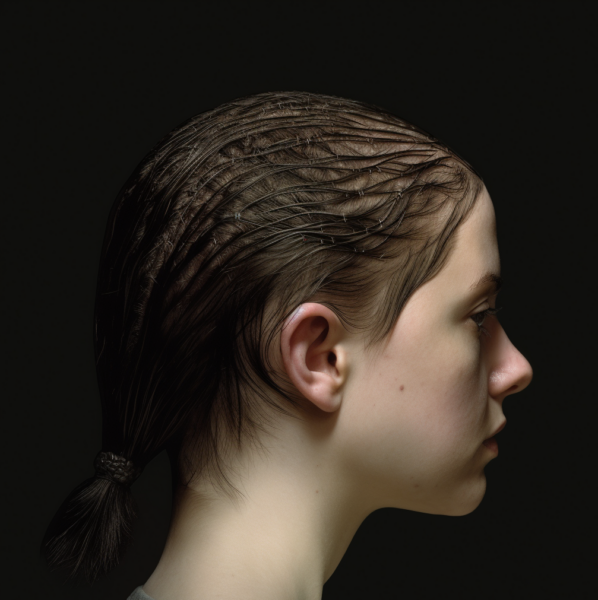Traction Alopecia (TA) is a common form of hair loss globally, though the prevalence varies significantly across different regions, populations, and cultural contexts. It is a form of hair loss typically attributed to forceful hairstyling methods that cause tension on the hair shaft, resulting in damage to the follicle. Despite the increasing number of people experiencing this condition worldwide, a dearth of comprehensive data clouds our understanding of its true prevalence, particularly among diverse populations. Underreporting may be a significant issue, particularly where hair loss from specific hairstyles is considered normal or culturally acceptable. Here we explore how common TA is in different parts of the world, and the reasons behind these variations in occurrence.
Studies conducted in different geographical locations have yielded varying prevalence rates across the world. A multicenter retrospective study involving specialist hair clinics in Europe, America, Africa, and Australia in 2019 shed light on the global variations in the prevalence of different types of alopecia, including TA. Out of 2,835 patients, 3,133 diagnoses of alopecia were made (patients can have more than one type of hair loss at the same time), revealing that TA was more prevalent in Africa (18%) compared to Europe (<1%), America (<1%), and Australia (<1%). The data clearly showed that Androgenetic Alopecia is the most common form of hair loss globally, with TA having a much lower overall prevalence. However, the higher occurrence of TA in Africa emphasizes the significant influence of geographical location and cultural practices on the prevalence of this condition.
A cross-sectional study conducted in Lagos, Nigeria, in people visiting a market provided valuable insight into the prevalence of various types of hair loss, including TA. Out of 307 participants, 68.7% reported some form of hair loss, and 71.7% of these cases were attributed to TA. Women were more significantly affected, with a hair loss prevalence of 77.3% compared to 51% in men. Notably, common hair care practices, such as braids and weave-on extensions (78.2%), turban-like head gear (76.9%), and chemical relaxers (73.8%) were predominant. These practices have long been associated with TA, suggesting their potential contribution to the high prevalence of the condition in Nigeria.
Similar findings were observed in a cross-sectional study in Cotonou, Benin. The study, which analyzed the medical records of new patients in a dermatology department, revealed a scalp disorder prevalence of 2.4% out of 7554 patients. Among the conditions diagnosed, TA accounted for 9.4% and occurred exclusively in women, mainly in the 25-40-year-old age group. This suggests a significant association between TA and gender, with women being more susceptible due to culturally specific hairstyling practices.
In older, but still valid studies, a general dermatology clinic in London noted a TA prevalence of 1.0% among black adults attending the clinic. Conversely, two studies from South Africa reported that 31.7% of women and 9.4% of children had TA, with a noticeable increase in prevalence with age. An American study cited TA in 18.4% of young girls, while a Nigerian study reported a relatively lower prevalence of 7.7% in women.
It should be noted that many of the older studies on traction alopecia have small sample sizes and lack details of their clinical and histological criteria, with potential confounding factors including pregnancy, malnutrition, and recall bias about regular hairstyles. However, even with these limitations in mind, the disparities in different studies suggest that TA prevalence varies widely among different populations across the world and even within the same population in specific regions. Demographically, it is clear that the highest incidence of TA is generally observed among women and children of African descent. A combination of the unique mechanical characteristics of African hair follicles likely contribute to this prevalence to some degree. However, it is also clear that differences in cultural hair-styling practices have the biggest single impact on the frequency of traction alopecia regardless of location or population.
Anaba et al. conducted a relatively extensive cross-sectional study in Nigeria, analyzing the community prevalence, pattern, severity, and trichoscopy features of Marginal Traction Alopecia (MTA) amongst adult Nigerian females. The prevalence was high at 76.3%, indicating that TA is pervasive among Nigerian women, with quite severe manifestations commonly observed.
Furthermore, another study investigating determinants of TA presence and severity in West African girls and women found that the risk of TA was significantly higher in adults and was associated with hair braiding-related symptoms. This connection between TA and hairdressing practices, especially adding traction to chemically treated hair, highlights a crucial area for intervention and public health education.
An American study further linked specific hair care practices with TA and other scalp conditions. The use of hair oils or grease was ubiquitous, with hairstyles like ponytails, braids, and cornrows being popular. The study found that cornrows significantly increased the odds of developing TA, as did the use of hair extensions and infrequent hair oil use, which were also linked to increased seborrheic dermatitis (itchy, scaly, inflamed skin).
Interestingly, TA is not limited to African or African diaspora populations. An occupational form of TA, commonly known as Nurse’s Cap Alopecia, has been observed among South Korean nurses, affecting 3.5% of the 199 nurses studied. This type of hair loss is attributed to the prolonged traction exerted by the pins used to secure the nurse’s cap.
In conclusion, while TA prevalence varies due to geographic locations and cultural practices, the condition is a global health concern, especially among women and children of African descent. Further research is needed to deepen our understanding of this condition, exploring other potential factors that could influence its incidence and severity. It’s essential to examine the implications of various hair care practices more extensively and consider potential confounding factors, such as socio-economic status, nutrition, and access to healthcare, which might contribute to the development of TA. Increased awareness and education on the consequences of certain hairstyling techniques, such as braiding and the use of chemical relaxers, are necessary to reduce the incidence of TA. With broader and more detailed studies, we can fill the existing knowledge gaps, fostering strategies to effectively combat this prevalent yet understudied condition. By doing so, we take a step towards addressing this global health concern, promoting safer hair care practices, and ultimately improving global hair health.
Bibliography
11711645 {11711645:XRD4W4GE},{11711645:V52GDRHS},{11711645:6HBZ7943},{11711645:9AZ7MM4B},{11711645:49SGND2C},{11711645:U89PVE7Q},{11711645:97HUZG4V},{11711645:CT37KKTW},{11711645:R97ZR3WU},{11711645:RS9BPVFZ},{11711645:AHA74JGR},{11711645:R5MB8U7S},{11711645:F97W6BHR} 1 vancouver 50 date asc 325 https://www.keratin.com/wp-content/plugins/zotpress/ %7B%22status%22%3A%22success%22%2C%22updateneeded%22%3Afalse%2C%22instance%22%3Afalse%2C%22meta%22%3A%7B%22request_last%22%3A0%2C%22request_next%22%3A0%2C%22used_cache%22%3Atrue%7D%2C%22data%22%3A%5B%7B%22key%22%3A%22R5MB8U7S%22%2C%22library%22%3A%7B%22id%22%3A11711645%7D%2C%22meta%22%3A%7B%22creatorSummary%22%3A%22Hwang%20et%20al.%22%2C%22parsedDate%22%3A%221999-03%22%2C%22numChildren%22%3A0%7D%2C%22bib%22%3A%22%26lt%3Bdiv%20class%3D%26quot%3Bcsl-bib-body%26quot%3B%20style%3D%26quot%3Bline-height%3A%201.35%3B%20%26quot%3B%26gt%3B%5Cn%20%20%26lt%3Bdiv%20class%3D%26quot%3Bcsl-entry%26quot%3B%20style%3D%26quot%3Bclear%3A%20left%3B%20%26quot%3B%26gt%3B%5Cn%20%20%20%20%26lt%3Bdiv%20class%3D%26quot%3Bcsl-left-margin%26quot%3B%20style%3D%26quot%3Bfloat%3A%20left%3B%20padding-right%3A%200.5em%3B%20text-align%3A%20right%3B%20width%3A%201em%3B%26quot%3B%26gt%3B1.%26lt%3B%5C%2Fdiv%26gt%3B%26lt%3Bdiv%20class%3D%26quot%3Bcsl-right-inline%26quot%3B%20style%3D%26quot%3Bmargin%3A%200%20.4em%200%201.5em%3B%26quot%3B%26gt%3BHwang%20SM%2C%20Lee%20WS%2C%20Choi%20EH%2C%20Lee%20SH%2C%20Ahn%20SK.%20Nurse%26%23x2019%3Bs%20cap%20alopecia.%20Int%20J%20Dermatol.%201999%20Mar%3B38%283%29%3A187%26%23x2013%3B91.%26lt%3B%5C%2Fdiv%26gt%3B%5Cn%20%20%20%26lt%3B%5C%2Fdiv%26gt%3B%5Cn%26lt%3B%5C%2Fdiv%26gt%3B%22%2C%22data%22%3A%7B%22itemType%22%3A%22journalArticle%22%2C%22title%22%3A%22Nurse%27s%20cap%20alopecia%22%2C%22creators%22%3A%5B%7B%22creatorType%22%3A%22author%22%2C%22firstName%22%3A%22S.%20M.%22%2C%22lastName%22%3A%22Hwang%22%7D%2C%7B%22creatorType%22%3A%22author%22%2C%22firstName%22%3A%22W.%20S.%22%2C%22lastName%22%3A%22Lee%22%7D%2C%7B%22creatorType%22%3A%22author%22%2C%22firstName%22%3A%22E.%20H.%22%2C%22lastName%22%3A%22Choi%22%7D%2C%7B%22creatorType%22%3A%22author%22%2C%22firstName%22%3A%22S.%20H.%22%2C%22lastName%22%3A%22Lee%22%7D%2C%7B%22creatorType%22%3A%22author%22%2C%22firstName%22%3A%22S.%20K.%22%2C%22lastName%22%3A%22Ahn%22%7D%5D%2C%22abstractNote%22%3A%22BACKGROUND%3A%20Traction%20alopecia%20associated%20with%20the%20nurse%26%23039%3Bs%20cap%20is%20a%20relatively%20common%20form%20of%20occupational%20hair%20loss.%5CnMETHODS%3A%20We%20examined%20199%20healthy%20South%20Korean%20nurses%20to%20assess%20the%20clinical%20and%20pathologic%20characteristics%20of%20traction%20alopecia%20caused%20by%20prolonged%20traction%20exerted%20at%20the%20point%20of%20attachment%20of%20the%20nurse%26%23039%3Bs%20cap.%5CnRESULTS%3A%20Seven%20nurses%20%283.5%25%20of%20199%29%20had%20hair%20loss%20at%20the%20pin%20site%20used%20to%20secure%20the%20nurse%26%23039%3Bs%20cap.%20The%20lesions%20were%20exclusively%20localized%20on%20the%20parieto-occipital%20scalp.%20Histopathologic%20findings%20revealed%20characteristic%20cicatricial%20changes%20which%20showed%20a%20marked%20decrease%20in%20the%20number%20of%20hair%20follicles%20without%20inflammation.%5CnCONCLUSIONS%3A%20Nurse%26%23039%3Bs%20cap%20alopecia%20is%20not%20an%20uncommon%20occupational%20alopecia%2C%20and%20appears%20to%20be%20a%20distinct%20clinical%20entity%20which%20should%20be%20distinguished%20from%20other%20forms%20of%20patchy%20alopecia.%22%2C%22date%22%3A%221999-03%22%2C%22language%22%3A%22eng%22%2C%22DOI%22%3A%2210.1046%5C%2Fj.1365-4362.1999.00556.x%22%2C%22ISSN%22%3A%220011-9059%22%2C%22url%22%3A%22%22%2C%22collections%22%3A%5B%22KBAIBN5W%22%5D%2C%22dateModified%22%3A%222023-07-04T14%3A27%3A23Z%22%7D%7D%2C%7B%22key%22%3A%22U89PVE7Q%22%2C%22library%22%3A%7B%22id%22%3A11711645%7D%2C%22meta%22%3A%7B%22creatorSummary%22%3A%22Khumalo%20et%20al.%22%2C%22parsedDate%22%3A%222007-07%22%2C%22numChildren%22%3A0%7D%2C%22bib%22%3A%22%26lt%3Bdiv%20class%3D%26quot%3Bcsl-bib-body%26quot%3B%20style%3D%26quot%3Bline-height%3A%201.35%3B%20%26quot%3B%26gt%3B%5Cn%20%20%26lt%3Bdiv%20class%3D%26quot%3Bcsl-entry%26quot%3B%20style%3D%26quot%3Bclear%3A%20left%3B%20%26quot%3B%26gt%3B%5Cn%20%20%20%20%26lt%3Bdiv%20class%3D%26quot%3Bcsl-left-margin%26quot%3B%20style%3D%26quot%3Bfloat%3A%20left%3B%20padding-right%3A%200.5em%3B%20text-align%3A%20right%3B%20width%3A%201em%3B%26quot%3B%26gt%3B1.%26lt%3B%5C%2Fdiv%26gt%3B%26lt%3Bdiv%20class%3D%26quot%3Bcsl-right-inline%26quot%3B%20style%3D%26quot%3Bmargin%3A%200%20.4em%200%201.5em%3B%26quot%3B%26gt%3BKhumalo%20NP%2C%20Jessop%20S%2C%20Gumedze%20F%2C%20Ehrlich%20R.%20Hairdressing%20is%20associated%20with%20scalp%20disease%20in%20African%20schoolchildren.%20Br%20J%20Dermatol.%202007%20July%3B157%281%29%3A106%26%23x2013%3B10.%26lt%3B%5C%2Fdiv%26gt%3B%5Cn%20%20%20%26lt%3B%5C%2Fdiv%26gt%3B%5Cn%26lt%3B%5C%2Fdiv%26gt%3B%22%2C%22data%22%3A%7B%22itemType%22%3A%22journalArticle%22%2C%22title%22%3A%22Hairdressing%20is%20associated%20with%20scalp%20disease%20in%20African%20schoolchildren%22%2C%22creators%22%3A%5B%7B%22creatorType%22%3A%22author%22%2C%22firstName%22%3A%22N.%20P.%22%2C%22lastName%22%3A%22Khumalo%22%7D%2C%7B%22creatorType%22%3A%22author%22%2C%22firstName%22%3A%22S.%22%2C%22lastName%22%3A%22Jessop%22%7D%2C%7B%22creatorType%22%3A%22author%22%2C%22firstName%22%3A%22F.%22%2C%22lastName%22%3A%22Gumedze%22%7D%2C%7B%22creatorType%22%3A%22author%22%2C%22firstName%22%3A%22R.%22%2C%22lastName%22%3A%22Ehrlich%22%7D%5D%2C%22abstractNote%22%3A%22BACKGROUND%3A%20Anecdotal%20reports%20suggest%20that%20certain%20disorders%20are%20common%20in%20African%20hair%20and%20may%20be%20associated%20with%20hairstyles.%5CnOBJECTIVES%3A%20A%20cross-sectional%20study%20of%201042%20schoolchildren%20was%20performed%20to%20test%20this%20hypothesis.%5CnMETHODS%3A%20A%20questionnaire%20was%20administered%20and%20scalp%20examinations%20performed%2C%20after%20ethics%20approval.%5CnRESULTS%3A%20Participants%20included%2045%25%20boys%20and%2055%25%20girls.%20The%20majority%20of%20boys%2C%2072.8%25%2C%20kept%20natural%20hair%20with%20frequent%20haircuts%20%28within%204%20weeks%29.%20The%20prevalence%20of%20acne%20%28folliculitis%29%20keloidalis%20nuchae%20%28AKN%29%20was%200.67%25%20in%20the%20whole%20group%20and%20highest%20%284.7%25%29%20in%20boys%20in%20the%20final%20year%20of%20high%20school%2C%20all%20of%20whom%20had%20frequent%20haircuts.%20The%20majority%20of%20girls%20%2878.4%25%29%20had%20chemically%20relaxed%20hair%2C%20which%20was%20usually%20combed%20back%20or%20tied%20in%20ponytails%2C%20vs.%208.6%25%20of%20boys.%20Traction%20alopecia%20%28TA%29%20was%20significantly%20more%20common%20with%20relaxed%20than%20natural%20hair%2C%20with%20an%20overall%20prevalence%20of%209.4%25%20%2898%20of%201042%29%20and%20of%2017.1%25%20in%20girls%2C%20in%20whom%20it%20increased%20with%20age%20from%208.6%25%20in%20the%20first%20year%20of%20school%20to%2021.7%25%20in%20the%20last%20year%20of%20high%20school.%20The%20proportion%20with%20TA%20in%20participants%20with%20a%20history%20of%20braids%20on%20natural%20hair%20was%20lower%20%2822.9%25%29%2C%20but%20not%20significantly%2C%20than%20among%20those%20with%20a%20history%20of%20braids%20on%20relaxed%20hair%20%2832.1%25%29.%20No%20cases%20of%20central%20centrifugal%20cicatricial%20alopecia%20were%20identified.%5CnCONCLUSIONS%3A%20We%20found%20associations%20between%20hairstyle%20and%20disease%20in%20our%20population%20of%20schoolchildren.%20AKN%20appears%20to%20be%20associated%20with%20frequently%20cut%20natural%20hair%20and%20TA%20with%20relaxed%20hair.%20These%20associations%20need%20further%20study%20for%20purposes%20of%20disease%20prevention.%22%2C%22date%22%3A%222007-07%22%2C%22language%22%3A%22eng%22%2C%22DOI%22%3A%2210.1111%5C%2Fj.1365-2133.2007.07987.x%22%2C%22ISSN%22%3A%220007-0963%22%2C%22url%22%3A%22%22%2C%22collections%22%3A%5B%22KBAIBN5W%22%5D%2C%22dateModified%22%3A%222023-07-04T14%3A27%3A35Z%22%7D%7D%2C%7B%22key%22%3A%2249SGND2C%22%2C%22library%22%3A%7B%22id%22%3A11711645%7D%2C%22meta%22%3A%7B%22creatorSummary%22%3A%22Khumalo%20et%20al.%22%2C%22parsedDate%22%3A%222007-11%22%2C%22numChildren%22%3A0%7D%2C%22bib%22%3A%22%26lt%3Bdiv%20class%3D%26quot%3Bcsl-bib-body%26quot%3B%20style%3D%26quot%3Bline-height%3A%201.35%3B%20%26quot%3B%26gt%3B%5Cn%20%20%26lt%3Bdiv%20class%3D%26quot%3Bcsl-entry%26quot%3B%20style%3D%26quot%3Bclear%3A%20left%3B%20%26quot%3B%26gt%3B%5Cn%20%20%20%20%26lt%3Bdiv%20class%3D%26quot%3Bcsl-left-margin%26quot%3B%20style%3D%26quot%3Bfloat%3A%20left%3B%20padding-right%3A%200.5em%3B%20text-align%3A%20right%3B%20width%3A%201em%3B%26quot%3B%26gt%3B1.%26lt%3B%5C%2Fdiv%26gt%3B%26lt%3Bdiv%20class%3D%26quot%3Bcsl-right-inline%26quot%3B%20style%3D%26quot%3Bmargin%3A%200%20.4em%200%201.5em%3B%26quot%3B%26gt%3BKhumalo%20NP%2C%20Jessop%20S%2C%20Gumedze%20F%2C%20Ehrlich%20R.%20Hairdressing%20and%20the%20prevalence%20of%20scalp%20disease%20in%20African%20adults.%20Br%20J%20Dermatol.%202007%20Nov%3B157%285%29%3A981%26%23x2013%3B8.%26lt%3B%5C%2Fdiv%26gt%3B%5Cn%20%20%20%26lt%3B%5C%2Fdiv%26gt%3B%5Cn%26lt%3B%5C%2Fdiv%26gt%3B%22%2C%22data%22%3A%7B%22itemType%22%3A%22journalArticle%22%2C%22title%22%3A%22Hairdressing%20and%20the%20prevalence%20of%20scalp%20disease%20in%20African%20adults%22%2C%22creators%22%3A%5B%7B%22creatorType%22%3A%22author%22%2C%22firstName%22%3A%22N.%20P.%22%2C%22lastName%22%3A%22Khumalo%22%7D%2C%7B%22creatorType%22%3A%22author%22%2C%22firstName%22%3A%22S.%22%2C%22lastName%22%3A%22Jessop%22%7D%2C%7B%22creatorType%22%3A%22author%22%2C%22firstName%22%3A%22F.%22%2C%22lastName%22%3A%22Gumedze%22%7D%2C%7B%22creatorType%22%3A%22author%22%2C%22firstName%22%3A%22R.%22%2C%22lastName%22%3A%22Ehrlich%22%7D%5D%2C%22abstractNote%22%3A%22BACKGROUND%3A%20Anecdotal%20reports%20suggest%20that%20certain%20scalp%20disorders%20are%20common%20in%20Africans%20and%20may%20be%20associated%20with%20hairstyles.%5CnOBJECTIVES%3A%20This%20study%20of%20874%20African%20adults%20in%20Cape%20Town%20was%20performed%20to%20test%20this%20hypothesis.%5CnMETHODS%3A%20A%20questionnaire%20was%20administered%20and%20scalp%20examinations%20performed%2C%20after%20ethics%20approval.%5CnRESULTS%3A%20Participants%20included%2030.9%25%20men%20and%2069.1%25%20women%20%28median%20age%2036.1%20years%2C%20range%2018-99%29.%20Most%20men%20had%20natural%20hair%3A%2091.7%25%20vs.%2024.3%25%20women.%20The%20majority%20of%20men%20had%20recent%20haircuts%20%28%26lt%3B%204%20weeks%29%3A%2074.8%25%20vs.%209.9%25%20women.%20The%20overall%20prevalence%20of%20acne%20%28folliculitis%29%20keloidalis%20nuchae%20%28AKN%29%20was%203.5%25%3A%20higher%20in%20men%20than%20women%20%2810.5%25%20vs.%200.3%25%29.%20AKN%20prevalence%20was%20not%20associated%20with%20whether%20clippers%20or%20blades%20were%20used.%20However%2C%20it%20was%20associated%20with%20haircut%20symptoms.%20Haircut-associated%20symptoms%2C%20i.e.%20at%20least%20one%20episode%20of%20transient%20pimples%20%28or%20crusts%29%20and%20bleeding%20%28however%20small%29%20were%20reported%20in%2037%25%20and%2018.9%25%20of%20men%2C%20respectively.%20The%20latter%20may%20have%20implications%20for%20disease%20transmission.%20Most%20women%20%2858.7%25%29%20had%20chemically%20treated%20hair%20%2849.2%25%20relaxed%20and%209.6%25%20permed%20hair%29%20vs.%202.3%25%20men.%20The%20prevalences%20of%20traction%20alopecia%20%28TA%29%20and%20central%20centrifugal%20cicatricial%20alopecia%20%28CCCA%29%20were%2022.6%25%20and%201.9%25%3A%20higher%20in%20women%20%2831.7%25%20vs.%202.2%25%20and%202.7%25%20vs.%200%25%2C%20respectively%29.%20CCCA%20was%20highest%20in%20women%20%26gt%3B%2050%20years%20%286.7%25%20vs.%201.2%25%29.%20TA%20prevalence%20was%20highest%20if%20the%20usual%20hairstyle%20was%20extensions%20attached%20to%20relaxed%20hair%20%2848%25%29.%5CnCONCLUSION%3A%20We%20found%20associations%20between%20specific%20scalp%20diseases%2C%20hairstyles%2C%20gender%2C%20and%20age.%20These%20associations%20need%20further%20study%2C%20better%20to%20elucidate%20determinants%20and%20to%20improve%20disease%20prevention%20and%20treatment.%22%2C%22date%22%3A%222007-11%22%2C%22language%22%3A%22eng%22%2C%22DOI%22%3A%2210.1111%5C%2Fj.1365-2133.2007.08146.x%22%2C%22ISSN%22%3A%220007-0963%22%2C%22url%22%3A%22%22%2C%22collections%22%3A%5B%22KBAIBN5W%22%5D%2C%22dateModified%22%3A%222023-07-04T14%3A27%3A46Z%22%7D%7D%2C%7B%22key%22%3A%2297HUZG4V%22%2C%22library%22%3A%7B%22id%22%3A11711645%7D%2C%22meta%22%3A%7B%22creatorSummary%22%3A%22Khumalo%20et%20al.%22%2C%22parsedDate%22%3A%222007-12%22%2C%22numChildren%22%3A0%7D%2C%22bib%22%3A%22%26lt%3Bdiv%20class%3D%26quot%3Bcsl-bib-body%26quot%3B%20style%3D%26quot%3Bline-height%3A%201.35%3B%20%26quot%3B%26gt%3B%5Cn%20%20%26lt%3Bdiv%20class%3D%26quot%3Bcsl-entry%26quot%3B%20style%3D%26quot%3Bclear%3A%20left%3B%20%26quot%3B%26gt%3B%5Cn%20%20%20%20%26lt%3Bdiv%20class%3D%26quot%3Bcsl-left-margin%26quot%3B%20style%3D%26quot%3Bfloat%3A%20left%3B%20padding-right%3A%200.5em%3B%20text-align%3A%20right%3B%20width%3A%201em%3B%26quot%3B%26gt%3B1.%26lt%3B%5C%2Fdiv%26gt%3B%26lt%3Bdiv%20class%3D%26quot%3Bcsl-right-inline%26quot%3B%20style%3D%26quot%3Bmargin%3A%200%20.4em%200%201.5em%3B%26quot%3B%26gt%3BKhumalo%20NP%2C%20Ngwanya%20RM%2C%20Jessop%20S%2C%20Gumedze%20F%2C%20Ehrlich%20R.%20Marginal%20traction%20alopecia%20severity%20score%3A%20development%20and%20test%20of%20reliability.%20J%20Cosmet%20Dermatol.%202007%20Dec%3B6%284%29%3A262%26%23x2013%3B9.%26lt%3B%5C%2Fdiv%26gt%3B%5Cn%20%20%20%26lt%3B%5C%2Fdiv%26gt%3B%5Cn%26lt%3B%5C%2Fdiv%26gt%3B%22%2C%22data%22%3A%7B%22itemType%22%3A%22journalArticle%22%2C%22title%22%3A%22Marginal%20traction%20alopecia%20severity%20score%3A%20development%20and%20test%20of%20reliability%22%2C%22creators%22%3A%5B%7B%22creatorType%22%3A%22author%22%2C%22firstName%22%3A%22N.%20P.%22%2C%22lastName%22%3A%22Khumalo%22%7D%2C%7B%22creatorType%22%3A%22author%22%2C%22firstName%22%3A%22R.%20M.%22%2C%22lastName%22%3A%22Ngwanya%22%7D%2C%7B%22creatorType%22%3A%22author%22%2C%22firstName%22%3A%22S.%22%2C%22lastName%22%3A%22Jessop%22%7D%2C%7B%22creatorType%22%3A%22author%22%2C%22firstName%22%3A%22F.%22%2C%22lastName%22%3A%22Gumedze%22%7D%2C%7B%22creatorType%22%3A%22author%22%2C%22firstName%22%3A%22R.%22%2C%22lastName%22%3A%22Ehrlich%22%7D%5D%2C%22abstractNote%22%3A%22BACKGROUND%3A%20Traction%20alopecia%20%28TA%29%20is%20common%20in%20African%20females.%20Although%20hairstyles%20are%20thought%20to%20be%20causal%2C%20the%20contribution%20of%20individual%20hairstyling%20variables%20to%20TA%20severity%20has%20not%20been%20quantified.%20The%20aim%20of%20the%20current%20study%20was%20to%20develop%20a%20severity%20scoring%20system%20%28M-TAS%20score%29%20for%20marginal%20TA%2C%20the%20commonest%20form%20of%20this%20disorder%2C%20and%20to%20test%20its%20reliability.%5CnMETHOD%3A%20The%20margins%20of%20the%20scalp%20were%20divided%20into%20anterior%20and%20posterior%20with%20an%20imaginary%20line%20joining%20the%20tips%20of%20both%20ears.%20The%20anterior%20and%20posterior%20hairlines%20were%20further%20divided%20into%20three%20using%20the%20temporalis%20muscles%20and%20mastoid%20processes%20at%20the%20hairline%20as%20landmarks%2C%20respectively.%20Each%20examiner%20assessed%20each%20of%20the%20six%20areas.%20If%20any%20were%20found%20to%20have%20TA%2C%20the%20severity%20was%20scored%20using%20an%20examiner%20assessed%20system%20%28tested%20once%29%20or%20a%20picture%20matched%20score%20%28tested%20twice%29.%20Ten%20and%20eight%20female%20patients%20with%20TA%20of%20varying%20severity%20were%20assessed%20by%2011%20and%209%20examiners%20%28dermatologists%2C%20dermatology%20trainees%2C%20and%20nurses%29%2C%20respectively.%5CnRESULTS%3A%20The%20intraclass%20correlation%20coefficient%20%28ICC%29%20for%20interobserver%20agreement%20was%20larger%20with%20photograph-matched%20scores%20than%20with%20examiner%20estimated%20scores%20reaching%20substantial%20%280.61-0.80%29%20and%20excellent%20%280.81-100%29%20agreement%20for%20both%20anterior%20and%20posterior%20scores%20irrespective%20of%20level%20of%20skill%20of%20examiner.%20The%20ICC%20for%20intraobserver%20agreement%20with%20the%20photograph%20matched%20scores%20was%200.99.%5CnLIMITATIONS%3A%20The%20diagnosis%20of%20normal%20margin%20was%20excellent%20for%20the%20anterior%20yet%20poor%20for%20the%20posterior%20margin%20with%20photograph%20scores.%20The%20M-TAS%20score%20is%20not%20for%20diagnosis%20but%20to%20assess%20severity.%5CnCONCLUSION%3A%20The%20photograph-based%20M-TAS%20score%20requires%20validation%20with%20larger%20samples%20but%20could%20be%20a%20useful%20research%20tool%20for%20elucidating%20disease%20prevalence%20and%20determinants%20of%20TA%20as%20well%20for%20monitoring%20response%20to%20treatment.%22%2C%22date%22%3A%222007-12%22%2C%22language%22%3A%22eng%22%2C%22DOI%22%3A%2210.1111%5C%2Fj.1473-2165.2007.00345.x%22%2C%22ISSN%22%3A%221473-2165%22%2C%22url%22%3A%22%22%2C%22collections%22%3A%5B%22842JZ582%22%5D%2C%22dateModified%22%3A%222023-07-01T16%3A27%3A31Z%22%7D%7D%2C%7B%22key%22%3A%229AZ7MM4B%22%2C%22library%22%3A%7B%22id%22%3A11711645%7D%2C%22meta%22%3A%7B%22creatorSummary%22%3A%22Khumalo%20et%20al.%22%2C%22parsedDate%22%3A%222008-09%22%2C%22numChildren%22%3A0%7D%2C%22bib%22%3A%22%26lt%3Bdiv%20class%3D%26quot%3Bcsl-bib-body%26quot%3B%20style%3D%26quot%3Bline-height%3A%201.35%3B%20%26quot%3B%26gt%3B%5Cn%20%20%26lt%3Bdiv%20class%3D%26quot%3Bcsl-entry%26quot%3B%20style%3D%26quot%3Bclear%3A%20left%3B%20%26quot%3B%26gt%3B%5Cn%20%20%20%20%26lt%3Bdiv%20class%3D%26quot%3Bcsl-left-margin%26quot%3B%20style%3D%26quot%3Bfloat%3A%20left%3B%20padding-right%3A%200.5em%3B%20text-align%3A%20right%3B%20width%3A%201em%3B%26quot%3B%26gt%3B1.%26lt%3B%5C%2Fdiv%26gt%3B%26lt%3Bdiv%20class%3D%26quot%3Bcsl-right-inline%26quot%3B%20style%3D%26quot%3Bmargin%3A%200%20.4em%200%201.5em%3B%26quot%3B%26gt%3BKhumalo%20NP%2C%20Jessop%20S%2C%20Gumedze%20F%2C%20Ehrlich%20R.%20Determinants%20of%20marginal%20traction%20alopecia%20in%20African%20girls%20and%20women.%20J%20Am%20Acad%20Dermatol.%202008%20Sept%3B59%283%29%3A432%26%23x2013%3B8.%26lt%3B%5C%2Fdiv%26gt%3B%5Cn%20%20%20%26lt%3B%5C%2Fdiv%26gt%3B%5Cn%26lt%3B%5C%2Fdiv%26gt%3B%22%2C%22data%22%3A%7B%22itemType%22%3A%22journalArticle%22%2C%22title%22%3A%22Determinants%20of%20marginal%20traction%20alopecia%20in%20African%20girls%20and%20women%22%2C%22creators%22%3A%5B%7B%22creatorType%22%3A%22author%22%2C%22firstName%22%3A%22Nonhlanhla%20P.%22%2C%22lastName%22%3A%22Khumalo%22%7D%2C%7B%22creatorType%22%3A%22author%22%2C%22firstName%22%3A%22Susan%22%2C%22lastName%22%3A%22Jessop%22%7D%2C%7B%22creatorType%22%3A%22author%22%2C%22firstName%22%3A%22Freedom%22%2C%22lastName%22%3A%22Gumedze%22%7D%2C%7B%22creatorType%22%3A%22author%22%2C%22firstName%22%3A%22Rodney%22%2C%22lastName%22%3A%22Ehrlich%22%7D%5D%2C%22abstractNote%22%3A%22BACKGROUND%3A%20Our%20recent%20population%20studies%20reported%20a%20prevalence%20of%20traction%20alopecia%20%28TA%29%20of%2017.1%25%20in%20African%20schoolgirls%20%286-21%20years%29%20and%20of%2031.7%25%20in%20women%20%2818-86%20years%29.%20More%20schoolgirls%20had%20chemically%20treated%20hair%20than%20women%20and%20disease%20presence%20was%20associated%20with%20hairstyles.%20The%20aim%20of%20this%20study%20was%20to%20investigate%20determinants%20of%20TA%20presence%20and%20severity%20in%20girls%20and%20women%20using%20data%20from%20both%20studies.%5CnMETHODS%3A%20Clinical%20assessment%20and%20a%20Marginal%20TA%20Severity%20score%20were%20used%20for%20diagnosis%20and%20disease%20severity%2C%20respectively.%20The%20data%20used%20included%20574%20schoolgirls%20and%20604%20women.%20The%20first%20analysis%20was%20multiple%20logistic%20regression%20for%20disease%20presence.%20Exploratory%20associations%20for%20disease%20severity%20were%20assessed%20using%20the%20Spearman%20rank%20correlation%20test.%20Adults%20were%20defined%20as%20age%2018%20years%20or%20older%2C%20irrespective%20of%20study.%5CnRESULTS%3A%20The%20odds%20ratio%20for%20TA%20was%20higher%20in%20adults%20than%20in%20children%20%28%26lt%3B18%20years%29%20%281.87%20%5BP%20%26lt%3B%20.001%2C%2095%25%20confidence%20interval%201.28-2.72%5D%29%20and%20was%20higher%20with%20braiding-related%20than%20chemical-related%20symptoms.%20The%20highest%20risk%20of%20TA%2C%20compared%20with%20natural%20hair%2C%20occurred%20when%20traction%20was%20added%20to%20relaxed%20hair%20%28odds%20ratio%203.47%20%5BP%20%26lt%3B%20.001%2C%2095%25%20confidence%20interval%201.94-6.20%5D%29.%20Only%2018.9%25%20of%20patients%20with%20TA%20had%20never%20had%20symptoms%20related%20to%20hairdressing.%20TA%20severity%20was%20associated%20with%20age%20group%2C%20current%20hairstyle%2C%20and%20hairdressing%20symptoms.%20Participants%20with%20severe%20disease%20were%20too%20few%20to%20estimate%20determinants.%5CnLIMITATIONS%3A%20There%20is%20a%20need%20for%20the%20validation%20of%20the%20Marginal%20TA%20Severity%20score%20with%20larger%20numbers%20and%20for%20future%20studies%20to%20include%20more%20participants%20with%20severe%20disease.%5CnCONCLUSIONS%3A%20Our%20findings%20suggest%20that%20avoiding%20both%20hairdressing%20symptoms%20and%20the%20addition%20of%20traction%2C%20especially%20to%20chemically%20processed%20hair%2C%20may%20reduce%20the%20risk%20of%20developing%20TA.%22%2C%22date%22%3A%222008-09%22%2C%22language%22%3A%22eng%22%2C%22DOI%22%3A%2210.1016%5C%2Fj.jaad.2008.05.036%22%2C%22ISSN%22%3A%221097-6787%22%2C%22url%22%3A%22%22%2C%22collections%22%3A%5B%22KBAIBN5W%22%5D%2C%22dateModified%22%3A%222023-07-04T14%3A28%3A00Z%22%7D%7D%2C%7B%22key%22%3A%22RS9BPVFZ%22%2C%22library%22%3A%7B%22id%22%3A11711645%7D%2C%22meta%22%3A%7B%22creatorSummary%22%3A%22Rucker%20Wright%20et%20al.%22%2C%22parsedDate%22%3A%222011-02%22%2C%22numChildren%22%3A0%7D%2C%22bib%22%3A%22%26lt%3Bdiv%20class%3D%26quot%3Bcsl-bib-body%26quot%3B%20style%3D%26quot%3Bline-height%3A%201.35%3B%20%26quot%3B%26gt%3B%5Cn%20%20%26lt%3Bdiv%20class%3D%26quot%3Bcsl-entry%26quot%3B%20style%3D%26quot%3Bclear%3A%20left%3B%20%26quot%3B%26gt%3B%5Cn%20%20%20%20%26lt%3Bdiv%20class%3D%26quot%3Bcsl-left-margin%26quot%3B%20style%3D%26quot%3Bfloat%3A%20left%3B%20padding-right%3A%200.5em%3B%20text-align%3A%20right%3B%20width%3A%201em%3B%26quot%3B%26gt%3B1.%26lt%3B%5C%2Fdiv%26gt%3B%26lt%3Bdiv%20class%3D%26quot%3Bcsl-right-inline%26quot%3B%20style%3D%26quot%3Bmargin%3A%200%20.4em%200%201.5em%3B%26quot%3B%26gt%3BRucker%20Wright%20D%2C%20Gathers%20R%2C%20Kapke%20A%2C%20Johnson%20D%2C%20Joseph%20CLM.%20Hair%20care%20practices%20and%20their%20association%20with%20scalp%20and%20hair%20disorders%20in%20African%20American%20girls.%20J%20Am%20Acad%20Dermatol.%202011%20Feb%3B64%282%29%3A253%26%23x2013%3B62.%26lt%3B%5C%2Fdiv%26gt%3B%5Cn%20%20%20%26lt%3B%5C%2Fdiv%26gt%3B%5Cn%26lt%3B%5C%2Fdiv%26gt%3B%22%2C%22data%22%3A%7B%22itemType%22%3A%22journalArticle%22%2C%22title%22%3A%22Hair%20care%20practices%20and%20their%20association%20with%20scalp%20and%20hair%20disorders%20in%20African%20American%20girls%22%2C%22creators%22%3A%5B%7B%22creatorType%22%3A%22author%22%2C%22firstName%22%3A%22Dakara%22%2C%22lastName%22%3A%22Rucker%20Wright%22%7D%2C%7B%22creatorType%22%3A%22author%22%2C%22firstName%22%3A%22Raechele%22%2C%22lastName%22%3A%22Gathers%22%7D%2C%7B%22creatorType%22%3A%22author%22%2C%22firstName%22%3A%22Alissa%22%2C%22lastName%22%3A%22Kapke%22%7D%2C%7B%22creatorType%22%3A%22author%22%2C%22firstName%22%3A%22Dayna%22%2C%22lastName%22%3A%22Johnson%22%7D%2C%7B%22creatorType%22%3A%22author%22%2C%22firstName%22%3A%22Christine%20L.%20M.%22%2C%22lastName%22%3A%22Joseph%22%7D%5D%2C%22abstractNote%22%3A%22BACKGROUND%3A%20Few%20studies%20have%20extensively%20examined%20the%20prevalence%20of%20hair%20care%20practices%20and%20their%20association%20with%20scalp%20and%20hair%20conditions%20in%20African%20American%20girls.%5CnOBJECTIVES%3A%20We%20sought%20to%20determine%20the%20prevalence%20of%20hair%20care%20practices%20and%20their%20association%20with%20traction%20alopecia%2C%20seborrheic%20dermatitis%20%28SD%29%2C%20and%20tinea%20capitis%20%28TC%29.%5CnMETHODS%3A%20A%20questionnaire%20was%20administered%20to%20caregivers%20of%20African%20American%20girls%20aged%201%20to%2015%20years.%20Multivariate%20analyses%20were%20performed%20to%20determine%20the%20association%20of%20hair%20care%20practices%20with%20reported%20disorders.%5CnRESULTS%3A%20A%20total%20of%20201%20surveys%20were%20completed%20from%20dermatology%20%28n%5Cu00a0%3D%2098%29%20and%20nondermatology%20%28n%5Cu00a0%3D%20103%29%20clinics.%20Mean%20patient%20age%20was%209.8%5Cu00a0%5Cu00b1%204.4%20years.%20Essentially%20all%20respondents%20reported%20use%20of%20hair%20oils%5C%2Fgrease%20%2899%25%29.%20Ponytails%2C%20braids%2C%20and%20cornrows%20were%20worn%20by%2081%25%2C%2067%25%2C%20and%2049%25%20of%20girls%2C%20respectively%2C%20within%20the%20past%2012%20months.%20In%20all%2C%2061%25%20reported%20hair%20washing%20every%202%20weeks%3B%2080%25%20used%20hot%20combs%3B%20and%2042%25%20used%20chemical%20relaxers.%20Cornrows%20were%20significantly%20related%20to%20traction%20alopecia%20among%20respondents%20from%20nondermatology%20clinics%20only%3A%20adjusted%20odds%20ratio%5Cu00a0%3D%205.79%20%2895%25%20CI%201.35-24.8%2C%20P%5Cu00a0%3D%20.018%29.%20Hair%20extensions%20and%20infrequent%20hair%20oil%20use%20were%20significantly%20related%20to%20SD%3A%20adjusted%20odds%20ratio%5Cu00a0%3D%202.37%20%2895%25%20CI%201.03-5.47%2C%20P%5Cu00a0%3D%20.04%29%20and%203.69%20%2895%25%20CI%201.07-12.7%2C%20P%5Cu00a0%3D%20.039%29%2C%20respectively.%20No%20significant%20associations%20were%20observed%20for%20TC.%5CnLIMITATIONS%3A%20Small%20sample%20size%20and%20disorders%20reported%20by%20caregivers%20were%20limitations.%5CnCONCLUSIONS%3A%20Certain%20hair%20care%20practices%20were%20strongly%20associated%20with%20development%20of%20traction%20alopecia%20and%20SD.%20No%20association%20was%20found%20between%20hair%20washing%20frequency%20and%20SD%20or%20TC%2C%20or%20between%20hair%20grease%20use%20and%20TC.%20These%20results%20can%20be%20used%20to%20inform%20practitioners%2C%20advise%20parents%2C%20and%20adapt%20treatment%20regimens%20to%20accommodate%20cultural%20preferences.%22%2C%22date%22%3A%222011-02%22%2C%22language%22%3A%22eng%22%2C%22DOI%22%3A%2210.1016%5C%2Fj.jaad.2010.05.037%22%2C%22ISSN%22%3A%221097-6787%22%2C%22url%22%3A%22%22%2C%22collections%22%3A%5B%22KBAIBN5W%22%5D%2C%22dateModified%22%3A%222023-07-04T14%3A28%3A15Z%22%7D%7D%2C%7B%22key%22%3A%22V52GDRHS%22%2C%22library%22%3A%7B%22id%22%3A11711645%7D%2C%22meta%22%3A%7B%22creatorSummary%22%3A%22Haskin%20and%20Aguh%22%2C%22parsedDate%22%3A%222016-09%22%2C%22numChildren%22%3A0%7D%2C%22bib%22%3A%22%26lt%3Bdiv%20class%3D%26quot%3Bcsl-bib-body%26quot%3B%20style%3D%26quot%3Bline-height%3A%201.35%3B%20%26quot%3B%26gt%3B%5Cn%20%20%26lt%3Bdiv%20class%3D%26quot%3Bcsl-entry%26quot%3B%20style%3D%26quot%3Bclear%3A%20left%3B%20%26quot%3B%26gt%3B%5Cn%20%20%20%20%26lt%3Bdiv%20class%3D%26quot%3Bcsl-left-margin%26quot%3B%20style%3D%26quot%3Bfloat%3A%20left%3B%20padding-right%3A%200.5em%3B%20text-align%3A%20right%3B%20width%3A%201em%3B%26quot%3B%26gt%3B1.%26lt%3B%5C%2Fdiv%26gt%3B%26lt%3Bdiv%20class%3D%26quot%3Bcsl-right-inline%26quot%3B%20style%3D%26quot%3Bmargin%3A%200%20.4em%200%201.5em%3B%26quot%3B%26gt%3BHaskin%20A%2C%20Aguh%20C.%20All%20hairstyles%20are%20not%20created%20equal%3A%20What%20the%20dermatologist%20needs%20to%20know%20about%20black%20hairstyling%20practices%20and%20the%20risk%20of%20traction%20alopecia%20%28TA%29.%20J%20Am%20Acad%20Dermatol.%202016%20Sept%3B75%283%29%3A606%26%23x2013%3B11.%26lt%3B%5C%2Fdiv%26gt%3B%5Cn%20%20%20%26lt%3B%5C%2Fdiv%26gt%3B%5Cn%26lt%3B%5C%2Fdiv%26gt%3B%22%2C%22data%22%3A%7B%22itemType%22%3A%22journalArticle%22%2C%22title%22%3A%22All%20hairstyles%20are%20not%20created%20equal%3A%20What%20the%20dermatologist%20needs%20to%20know%20about%20black%20hairstyling%20practices%20and%20the%20risk%20of%20traction%20alopecia%20%28TA%29%22%2C%22creators%22%3A%5B%7B%22creatorType%22%3A%22author%22%2C%22firstName%22%3A%22Alessandra%22%2C%22lastName%22%3A%22Haskin%22%7D%2C%7B%22creatorType%22%3A%22author%22%2C%22firstName%22%3A%22Crystal%22%2C%22lastName%22%3A%22Aguh%22%7D%5D%2C%22abstractNote%22%3A%22Prevalent%20among%20black%20women%2C%20traction%20alopecia%20%28TA%29%20is%20a%20type%20of%20hair%20loss%20that%20is%20often%20attributed%20to%20certain%20hairstyling%20practices.%20Although%20some%20of%20the%20hair%20care%20techniques%20common%20in%20the%20black%20community%20can%20promote%20ease%20of%20everyday%20hairstyling%20for%20black%20women%2C%20many%20of%20these%20practices%20have%20been%20implicated%20as%20risk%20factors%20for%20TA.%20Because%20of%20the%20limited%20literature%20on%20black%20hairstyling%20methods%2C%20hair%20loss%20in%20this%20patient%20population%20can%20present%20a%20diagnostic%20and%20therapeutic%20challenge%20for%20dermatologists.%20By%20increasing%20the%20knowledge%20and%20understanding%20of%20these%20practices%20and%20their%20risk%20of%20causing%20TA%2C%20clinicians%20can%20better%20manage%20this%20condition%20and%20stop%20the%20progression%20of%20hair%20loss%20before%20it%20becomes%20permanent.%20This%20information%20can%20be%20used%20to%20develop%20individualized%20recommendations%20for%20safer%20styling%20alternatives%20and%20improve%20patient%20education%20by%20identifying%20high-risk%20hairstyling%20habits.%20This%20review%20stratifies%20these%20hair%20care%20and%20styling%20practices%20into%20high-%2C%20moderate-%2C%20and%20low-risk%20categories%2C%20in%20addition%20to%20outlining%20a%20diagnostic%20approach%20for%20TA%20and%20detailed%20guidelines%20for%20conservative%20management.%22%2C%22date%22%3A%222016-09%22%2C%22language%22%3A%22eng%22%2C%22DOI%22%3A%2210.1016%5C%2Fj.jaad.2016.02.1162%22%2C%22ISSN%22%3A%221097-6787%22%2C%22url%22%3A%22%22%2C%22collections%22%3A%5B%22KBAIBN5W%22%5D%2C%22dateModified%22%3A%222023-07-04T14%3A28%3A29Z%22%7D%7D%2C%7B%22key%22%3A%22R97ZR3WU%22%2C%22library%22%3A%7B%22id%22%3A11711645%7D%2C%22meta%22%3A%7B%22creatorSummary%22%3A%22Va%5Cu00f1%5Cu00f3-Galv%5Cu00e1n%20et%20al.%22%2C%22parsedDate%22%3A%222019-08%22%2C%22numChildren%22%3A0%7D%2C%22bib%22%3A%22%26lt%3Bdiv%20class%3D%26quot%3Bcsl-bib-body%26quot%3B%20style%3D%26quot%3Bline-height%3A%201.35%3B%20%26quot%3B%26gt%3B%5Cn%20%20%26lt%3Bdiv%20class%3D%26quot%3Bcsl-entry%26quot%3B%20style%3D%26quot%3Bclear%3A%20left%3B%20%26quot%3B%26gt%3B%5Cn%20%20%20%20%26lt%3Bdiv%20class%3D%26quot%3Bcsl-left-margin%26quot%3B%20style%3D%26quot%3Bfloat%3A%20left%3B%20padding-right%3A%200.5em%3B%20text-align%3A%20right%3B%20width%3A%201em%3B%26quot%3B%26gt%3B1.%26lt%3B%5C%2Fdiv%26gt%3B%26lt%3Bdiv%20class%3D%26quot%3Bcsl-right-inline%26quot%3B%20style%3D%26quot%3Bmargin%3A%200%20.4em%200%201.5em%3B%26quot%3B%26gt%3BVa%26%23xF1%3B%26%23xF3%3B-Galv%26%23xE1%3Bn%20S%2C%20Saceda-Corralo%20D%2C%20Blume-Peytavi%20U%2C%20Cucch%26%23xED%3Ba%20J%2C%20Dlova%20NC%2C%20Gavazzoni%20Dias%20MFR%2C%20et%20al.%20Frequency%20of%20the%20Types%20of%20Alopecia%20at%20Twenty-Two%20Specialist%20Hair%20Clinics%3A%20A%20Multicenter%20Study.%20Skin%20Appendage%20Disord.%202019%20Aug%3B5%285%29%3A309%26%23x2013%3B15.%26lt%3B%5C%2Fdiv%26gt%3B%5Cn%20%20%20%26lt%3B%5C%2Fdiv%26gt%3B%5Cn%26lt%3B%5C%2Fdiv%26gt%3B%22%2C%22data%22%3A%7B%22itemType%22%3A%22journalArticle%22%2C%22title%22%3A%22Frequency%20of%20the%20Types%20of%20Alopecia%20at%20Twenty-Two%20Specialist%20Hair%20Clinics%3A%20A%20Multicenter%20Study%22%2C%22creators%22%3A%5B%7B%22creatorType%22%3A%22author%22%2C%22firstName%22%3A%22Sergio%22%2C%22lastName%22%3A%22Va%5Cu00f1%5Cu00f3-Galv%5Cu00e1n%22%7D%2C%7B%22creatorType%22%3A%22author%22%2C%22firstName%22%3A%22David%22%2C%22lastName%22%3A%22Saceda-Corralo%22%7D%2C%7B%22creatorType%22%3A%22author%22%2C%22firstName%22%3A%22Ulrike%22%2C%22lastName%22%3A%22Blume-Peytavi%22%7D%2C%7B%22creatorType%22%3A%22author%22%2C%22firstName%22%3A%22Jose%22%2C%22lastName%22%3A%22Cucch%5Cu00eda%22%7D%2C%7B%22creatorType%22%3A%22author%22%2C%22firstName%22%3A%22Ncoza%20C.%22%2C%22lastName%22%3A%22Dlova%22%7D%2C%7B%22creatorType%22%3A%22author%22%2C%22firstName%22%3A%22Maria%20Fernanda%20Reis%22%2C%22lastName%22%3A%22Gavazzoni%20Dias%22%7D%2C%7B%22creatorType%22%3A%22author%22%2C%22firstName%22%3A%22Ramon%22%2C%22lastName%22%3A%22Grimalt%22%7D%2C%7B%22creatorType%22%3A%22author%22%2C%22firstName%22%3A%22Daniela%22%2C%22lastName%22%3A%22Guzm%5Cu00e1n-S%5Cu00e1nchez%22%7D%2C%7B%22creatorType%22%3A%22author%22%2C%22firstName%22%3A%22Matthew%22%2C%22lastName%22%3A%22Harries%22%7D%2C%7B%22creatorType%22%3A%22author%22%2C%22firstName%22%3A%22Anthony%22%2C%22lastName%22%3A%22Ho%22%7D%2C%7B%22creatorType%22%3A%22author%22%2C%22firstName%22%3A%22Susan%22%2C%22lastName%22%3A%22Holmes%22%7D%2C%7B%22creatorType%22%3A%22author%22%2C%22firstName%22%3A%22Jorge%22%2C%22lastName%22%3A%22Larrondo%22%7D%2C%7B%22creatorType%22%3A%22author%22%2C%22firstName%22%3A%22Anisa%22%2C%22lastName%22%3A%22Mosam%22%7D%2C%7B%22creatorType%22%3A%22author%22%2C%22firstName%22%3A%22Rui%22%2C%22lastName%22%3A%22Oliveira-Soares%22%7D%2C%7B%22creatorType%22%3A%22author%22%2C%22firstName%22%3A%22Giselle%20M.%22%2C%22lastName%22%3A%22Pinto%22%7D%2C%7B%22creatorType%22%3A%22author%22%2C%22firstName%22%3A%22Bianca%20M.%22%2C%22lastName%22%3A%22Piraccini%22%7D%2C%7B%22creatorType%22%3A%22author%22%2C%22firstName%22%3A%22Rodrigo%22%2C%22lastName%22%3A%22Pirmez%22%7D%2C%7B%22creatorType%22%3A%22author%22%2C%22firstName%22%3A%22Daniel%22%2C%22lastName%22%3A%22De%20la%20Rosa%20Carrillo%22%7D%2C%7B%22creatorType%22%3A%22author%22%2C%22firstName%22%3A%22Lidia%22%2C%22lastName%22%3A%22Rudnicka%22%7D%2C%7B%22creatorType%22%3A%22author%22%2C%22firstName%22%3A%22Jerry%22%2C%22lastName%22%3A%22Shapiro%22%7D%2C%7B%22creatorType%22%3A%22author%22%2C%22firstName%22%3A%22Rodney%22%2C%22lastName%22%3A%22Sinclair%22%7D%2C%7B%22creatorType%22%3A%22author%22%2C%22firstName%22%3A%22Antonella%22%2C%22lastName%22%3A%22Tosti%22%7D%2C%7B%22creatorType%22%3A%22author%22%2C%22firstName%22%3A%22Ralph%20M.%22%2C%22lastName%22%3A%22Tr%5Cu00fceb%22%7D%2C%7B%22creatorType%22%3A%22author%22%2C%22firstName%22%3A%22Annika%22%2C%22lastName%22%3A%22Vogt%22%7D%2C%7B%22creatorType%22%3A%22author%22%2C%22firstName%22%3A%22Mariya%22%2C%22lastName%22%3A%22Miteva%22%7D%5D%2C%22abstractNote%22%3A%22BACKGROUND%3A%20The%20frequency%20of%20different%20types%20of%20alopecia%20is%20not%20clearly%20reported%20in%20recent%20studies.%5CnOBJECTIVE%3A%20To%20analyze%20the%20frequency%20of%20the%20types%20of%20alopecia%20in%20patients%20consulting%20at%20specialist%20hair%20clinics%20%28SHC%29%20and%20to%20assess%20for%20global%20variations.%5CnMETHODS%3A%20Multicenter%20retrospective%20study%20including%20data%20from%20patients%20evaluated%20at%20referral%20SHC%20in%20Europe%2C%20America%2C%20Africa%20and%20Australia.%5CnRESULTS%3A%20A%20total%20of%202%2C835%20patients%20%2872.7%25%20females%20and%2027.3%25%20males%29%20with%203%2C133%20diagnoses%20of%20alopecia%20were%20included%20%2873%25%20were%20non-cicatricial%20and%2027%25%20were%20cicatricial%20alopecias%29.%20In%20all%2C%2057%20different%20types%20of%20alopecia%20were%20characterized.%20The%20most%20frequent%20type%20was%20androgenetic%20alopecia%20%28AGA%29%20%2837.7%25%29%2C%20followed%20by%20alopecia%20areata%20%28AA%29%20%2818.2%25%29%2C%20telogen%20effluvium%20%28TE%29%20%2811.3%25%29%2C%20frontal%20fibrosing%20alopecia%20%28FFA%29%20%2810.8%25%29%2C%20lichen%20planopilaris%20%28LPP%29%20%287.6%25%29%2C%20folliculitis%20decalvans%20%28FD%29%20%282.8%25%29%2C%20discoid%20lupus%20%281.9%25%29%20and%20fibrosing%20alopecia%20in%20a%20pattern%20distribution%20%28FAPD%29%20%281.8%25%29.%20There%20was%20a%20male%20predominance%20in%20patients%20with%20acne%20keloidalis%20nuchae%2C%20dissecting%20cellulitis%20and%20FD%2C%20and%20female%20predominance%20in%20traction%20alopecia%2C%20central%20centrifugal%20cicatricial%20alopecia%2C%20FFA%2C%20TE%2C%20FAPD%20and%20LPP.%5CnCONCLUSION%3A%20AGA%20followed%20by%20AA%20and%20TE%20were%20the%20most%20frequent%20cause%20of%20non-cicatricial%20alopecia%2C%20while%20FFA%20was%20the%20most%20frequent%20cause%20of%20cicatricial%20alopecia%20in%20all%20studied%20geographical%20areas.%22%2C%22date%22%3A%222019-08%22%2C%22language%22%3A%22eng%22%2C%22DOI%22%3A%2210.1159%5C%2F000496708%22%2C%22ISSN%22%3A%222296-9195%22%2C%22url%22%3A%22%22%2C%22collections%22%3A%5B%22KBAIBN5W%22%5D%2C%22dateModified%22%3A%222023-07-04T14%3A28%3A43Z%22%7D%7D%2C%7B%22key%22%3A%22XRD4W4GE%22%2C%22library%22%3A%7B%22id%22%3A11711645%7D%2C%22meta%22%3A%7B%22creatorSummary%22%3A%22D%5Cu00e9gbo%5Cu00e9%20et%20al.%22%2C%22parsedDate%22%3A%222020%22%2C%22numChildren%22%3A0%7D%2C%22bib%22%3A%22%26lt%3Bdiv%20class%3D%26quot%3Bcsl-bib-body%26quot%3B%20style%3D%26quot%3Bline-height%3A%201.35%3B%20%26quot%3B%26gt%3B%5Cn%20%20%26lt%3Bdiv%20class%3D%26quot%3Bcsl-entry%26quot%3B%20style%3D%26quot%3Bclear%3A%20left%3B%20%26quot%3B%26gt%3B%5Cn%20%20%20%20%26lt%3Bdiv%20class%3D%26quot%3Bcsl-left-margin%26quot%3B%20style%3D%26quot%3Bfloat%3A%20left%3B%20padding-right%3A%200.5em%3B%20text-align%3A%20right%3B%20width%3A%201em%3B%26quot%3B%26gt%3B1.%26lt%3B%5C%2Fdiv%26gt%3B%26lt%3Bdiv%20class%3D%26quot%3Bcsl-right-inline%26quot%3B%20style%3D%26quot%3Bmargin%3A%200%20.4em%200%201.5em%3B%26quot%3B%26gt%3BD%26%23xE9%3Bgbo%26%23xE9%3B%20B%2C%20Koudoukpo%20C%2C%20Habib%20A%2C%20Kouassi%20A%2C%20Djodjo%20M%2C%20Akpadjan%20F%2C%20et%20al.%20%5BScalp%20disorders%20in%20black%20Africans%20treated%20in%20a%20dermatology%20department%20in%20Cotonou%20%28Benin%29%3A%20age-sex-specific%20epidemiological%20and%20clinical%20features%5D.%20Pan%20Afr%20Med%20J.%202020%3B37%3A303.%26lt%3B%5C%2Fdiv%26gt%3B%5Cn%20%20%20%26lt%3B%5C%2Fdiv%26gt%3B%5Cn%26lt%3B%5C%2Fdiv%26gt%3B%22%2C%22data%22%3A%7B%22itemType%22%3A%22journalArticle%22%2C%22title%22%3A%22%5BScalp%20disorders%20in%20black%20Africans%20treated%20in%20a%20dermatology%20department%20in%20Cotonou%20%28Benin%29%3A%20age-sex-specific%20epidemiological%20and%20clinical%20features%5D%22%2C%22creators%22%3A%5B%7B%22creatorType%22%3A%22author%22%2C%22firstName%22%3A%22B%5Cu00e9r%5Cu00e9nice%22%2C%22lastName%22%3A%22D%5Cu00e9gbo%5Cu00e9%22%7D%2C%7B%22creatorType%22%3A%22author%22%2C%22firstName%22%3A%22Christiane%22%2C%22lastName%22%3A%22Koudoukpo%22%7D%2C%7B%22creatorType%22%3A%22author%22%2C%22firstName%22%3A%22Akimath%22%2C%22lastName%22%3A%22Habib%22%7D%2C%7B%22creatorType%22%3A%22author%22%2C%22firstName%22%3A%22Alida%22%2C%22lastName%22%3A%22Kouassi%22%7D%2C%7B%22creatorType%22%3A%22author%22%2C%22firstName%22%3A%22Masudi%22%2C%22lastName%22%3A%22Djodjo%22%7D%2C%7B%22creatorType%22%3A%22author%22%2C%22firstName%22%3A%22Fabrice%22%2C%22lastName%22%3A%22Akpadjan%22%7D%2C%7B%22creatorType%22%3A%22author%22%2C%22firstName%22%3A%22Hugues%22%2C%22lastName%22%3A%22Ad%5Cu00e9gbidi%22%7D%2C%7B%22creatorType%22%3A%22author%22%2C%22firstName%22%3A%22F%5Cu00e9lix%22%2C%22lastName%22%3A%22Atadokp%5Cu00e8d%5Cu00e9%22%7D%5D%2C%22abstractNote%22%3A%22INTRODUCTION%3A%20scalp%20disorders%20are%20related%20to%20several%20factors%20including%20ethnicity%2C%20gender%20or%20age.%20In%20black%20people%2C%20they%20can%20be%20caused%20by%20intrinsic%20and%20extrinsic%20factors.%20Very%20few%20studies%20have%20been%20conducted%20in%20this%20ethnic%20group%20residing%20in%20black%20Africa%2C%20hence%20the%20purpose%20of%20our%20survey%20was%20to%20highlight%20the%20epidemiological%20and%20clinical%20features%20of%20age-sex-specific%20scalp%20disorders%20in%20patients%20treated%20in%20a%20dermatology%20department%20in%20Cotonou%20%28Benin%29.%5CnMETHODS%3A%20we%20conducted%20a%20retrospective%20and%20descriptive%20study%20of%20all%20the%20medical%20records%20of%20new%20patients%20coming%20to%20consultation%20in%20the%20dermatology%20department%20at%20the%20National%20Hospital%20and%20University%20Center%20%28CNHU%29%20of%20Cotonou%20over%20a%20period%20of%20seven%20years.%20The%20main%20reason%20for%20consultation%20was%20scalp%20disorder.%20Data%20on%20epidemiological%20and%20clinical%20features%20were%20collected%20and%20analyzed%20with%20the%20EPI-Info%207%20software.%5CnRESULTS%3A%20prevalence%20of%20scalp%20disorders%20was%202.4%25%20%28181%5C%2F7554%29.%20Children%20%280-18%20years%29%20accounted%20for%2038.7%25%20%2870%20patients%29%20and%20adults%2061.3%25%20%28111%20patients%29.%20Children%20aged%200-10%20%2854%3B%2029.8%25%29%20and%20adults%20aged%2025-40%20%2851%3B%2028%2C2%25%29%20were%20the%20most%20affected.%20Sex%20ratio%20was%201.8.%20Non-alopecizing%20dermatosis%20was%20diagnosed%20in%2010%3B%205.5%25%20of%20cases%20while%20alopecizing%20dermatosis%20in%20171%20patients%20%2894.5%25%29%2C%20of%20whom%2082.9%25%20%28151%5C%2F171%29%20had%20non-scarring%20dermatosis%20and%2011.7%25%20%2820%5C%2F171%29%20had%20scarring%20dermatosis.%20The%20most%20common%20conditions%20were%20ringworm%20%2841%3B%2022.6%25%29%2C%20mainly%20occurring%20in%200-10-year-old%20boys%2C%20chronic%20non-scarring%20folliculitis%20%2839%3B%2021.5%25%29%20mainly%20occurring%20in%200-5-year-old%20boys%20and%2019-40-year-old%20men%2C%20pelade%20%2838%3B%2021%25%29%20occurring%20in%20both%20male%20and%20female%20sexes%2C%20especially%20between%20the%20ages%20of%206-10%20and%2025-40%2C%20traction%20alopecia%20%2817%3B%209.4%25%29%20occurring%20exclusively%20in%20women%20and%20mainly%20in%20the%2025-40-year-old%20age%20group%2C%20fibrous%20folliculitis%20at%20the%20nape%20of%20the%20neck%20%2812%3B%206.6%25%29%20occurring%20exclusively%20in%20men%20from%2019%20to%2050%20years%2C%20trichotillomania%20%289%3B%205%25%29%20occurring%20in%20both%20male%20and%20female%20sexes%2C%20mainly%20in%20children%20aged%206-10%20years%20and%20in%20adults%20aged%2025-40%20years%2C%20Quinquaud%20folliculitis%20decalvans%20%286%3B%203.3%25%29%20occurring%20uniformly%20in%20both%20male%20and%20female%20sexes%20and%20mainly%20between%2025-40%20years%20of%20age.%5CnCONCLUSION%3A%20scalp%20disorders%20mainly%20affect%20male%20patients%20before%20puberty%20and%20young%20adults.%20They%20were%20arranged%20in%20descending%20order%20in%20non-scarring%20alopecizing%20dermatoses%2C%20scarring%20alopecia%20and%20non-alopecizing%20dermatoses.%22%2C%22date%22%3A%222020%22%2C%22language%22%3A%22fre%22%2C%22DOI%22%3A%2210.11604%5C%2Fpamj.2020.37.303.20997%22%2C%22ISSN%22%3A%221937-8688%22%2C%22url%22%3A%22%22%2C%22collections%22%3A%5B%22KBAIBN5W%22%5D%2C%22dateModified%22%3A%222023-07-04T14%3A28%3A57Z%22%7D%7D%2C%7B%22key%22%3A%22AHA74JGR%22%2C%22library%22%3A%7B%22id%22%3A11711645%7D%2C%22meta%22%3A%7B%22creatorSummary%22%3A%22Anaba%20et%20al.%22%2C%22parsedDate%22%3A%222022-08-31%22%2C%22numChildren%22%3A0%7D%2C%22bib%22%3A%22%26lt%3Bdiv%20class%3D%26quot%3Bcsl-bib-body%26quot%3B%20style%3D%26quot%3Bline-height%3A%201.35%3B%20%26quot%3B%26gt%3B%5Cn%20%20%26lt%3Bdiv%20class%3D%26quot%3Bcsl-entry%26quot%3B%20style%3D%26quot%3Bclear%3A%20left%3B%20%26quot%3B%26gt%3B%5Cn%20%20%20%20%26lt%3Bdiv%20class%3D%26quot%3Bcsl-left-margin%26quot%3B%20style%3D%26quot%3Bfloat%3A%20left%3B%20padding-right%3A%200.5em%3B%20text-align%3A%20right%3B%20width%3A%201em%3B%26quot%3B%26gt%3B1.%26lt%3B%5C%2Fdiv%26gt%3B%26lt%3Bdiv%20class%3D%26quot%3Bcsl-right-inline%26quot%3B%20style%3D%26quot%3Bmargin%3A%200%20.4em%200%201.5em%3B%26quot%3B%26gt%3BAnaba%20EL%2C%20Akinkugbe%20EO%2C%20Otrofanowei%20E%2C%20Adeife-Cole%20O%2C%20Ayanlowo%20O%2C%20Oaku%20I%2C%20et%20al.%20Marginal%20Traction%20Alopecia%3A%20Hair%20Care%20Practices%2C%20Severity%20Score%20and%20Trichoscopic%20Features%20in%20Lagos%2C%20Nigeria.%20West%20Afr%20J%20Med.%202022%20Aug%2031%3B39%288%29%3A808%26%23x2013%3B15.%26lt%3B%5C%2Fdiv%26gt%3B%5Cn%20%20%20%26lt%3B%5C%2Fdiv%26gt%3B%5Cn%26lt%3B%5C%2Fdiv%26gt%3B%22%2C%22data%22%3A%7B%22itemType%22%3A%22journalArticle%22%2C%22title%22%3A%22Marginal%20Traction%20Alopecia%3A%20Hair%20Care%20Practices%2C%20Severity%20Score%20and%20Trichoscopic%20Features%20in%20Lagos%2C%20Nigeria%22%2C%22creators%22%3A%5B%7B%22creatorType%22%3A%22author%22%2C%22firstName%22%3A%22E.%20L.%22%2C%22lastName%22%3A%22Anaba%22%7D%2C%7B%22creatorType%22%3A%22author%22%2C%22firstName%22%3A%22E.%20O.%22%2C%22lastName%22%3A%22Akinkugbe%22%7D%2C%7B%22creatorType%22%3A%22author%22%2C%22firstName%22%3A%22E.%22%2C%22lastName%22%3A%22Otrofanowei%22%7D%2C%7B%22creatorType%22%3A%22author%22%2C%22firstName%22%3A%22O.%22%2C%22lastName%22%3A%22Adeife-Cole%22%7D%2C%7B%22creatorType%22%3A%22author%22%2C%22firstName%22%3A%22O.%22%2C%22lastName%22%3A%22Ayanlowo%22%7D%2C%7B%22creatorType%22%3A%22author%22%2C%22firstName%22%3A%22I.%22%2C%22lastName%22%3A%22Oaku%22%7D%2C%7B%22creatorType%22%3A%22author%22%2C%22firstName%22%3A%22I.%22%2C%22lastName%22%3A%22Akwara%22%7D%5D%2C%22abstractNote%22%3A%22BACKGROUND%3A%20Marginal%20traction%20alopecia%20%28MTA%29%20is%20commonly%20observed%20in%20adult%20females.%20Studies%20of%20prevalence%2C%20severity%2C%20trichoscopy%20and%20severity%20scoring%20are%20few.%5CnOBJECTIVE%3A%20The%20aim%20of%20this%20study%20was%20to%20determine%20the%20community%20prevalence%2C%20pattern%2C%20severity%20score%20and%20trichoscopy%20features%20of%20MTA%20amongst%20adult%20Nigerian%20females.%20Patient%20and%20method%3A%20This%20was%20a%20cross-sectional%20descriptive%20study%20of%20a%20cohort%20of%20207%20adult%20females%20in%20a%20community%20in%20Lagos%2C%20Nigeria.%20The%20participants%20were%20clinically%20evaluated%20for%20MTA.%20Sociodemographic%2C%20clinical%20and%20trichoscopy%20data%20was%20documented.%20Severity%20score%20was%20documented%20using%20the%20MTA%20severity%20score.%20Data%20was%20analyzed%20using%20SPSS%20version%2022.%5CnRESULTS%3A%20The%20mean%20age%20of%20participants%20was%2043%5Cu00b112.8%20years%20and%20the%20prevalence%20of%20MTA%20was%2076.3%25.%20Marginal%20traction%20alopecia%20was%20frontoccipital%20in%2065.2%25.%20The%20MTA%20score%20was%201-3%20in%2022.2%25%2C%204-6%20in%2029.7%25%20and%20%5Cu22656%20in%2048.1%25.%20Fringe%20sign%20was%20observed%20in%2030.4%25%2C%20folliculitis%20in%209.5%25%20and%2013.9%25%20had%20tight%20weaves.%20Trichoscopic%20features%20included%20preserved%20honeycomb%20pigment%2C%20preserved%20white%20dot%20architecture%2C%20varying%20hair%20length%20and%20single%20hairs%20from%20hair%20follicles.%5CnCONCLUSION%3A%20Marginal%20traction%20alopecia%20is%20common%20in%20Nigerian%20women.%20It%20is%20mostly%20severe%2C%20severity%20is%20not%20significantly%20associated%20with%20haircare%20practices%20and%20it%20is%20represented%20by%20common%20trichoscopy%20features.%20Appropriate%20awareness%20and%20education%20of%20females%20on%20hair%20styles%20can%20mitigate%20this%20hair%20loss.%22%2C%22date%22%3A%222022-08-31%22%2C%22language%22%3A%22eng%22%2C%22DOI%22%3A%22%22%2C%22ISSN%22%3A%220189-160X%22%2C%22url%22%3A%22%22%2C%22collections%22%3A%5B%22KBAIBN5W%22%5D%2C%22dateModified%22%3A%222023-07-04T14%3A29%3A36Z%22%7D%7D%2C%7B%22key%22%3A%226HBZ7943%22%2C%22library%22%3A%7B%22id%22%3A11711645%7D%2C%22meta%22%3A%7B%22creatorSummary%22%3A%22Anaba%20et%20al.%22%2C%22parsedDate%22%3A%222022-10-20%22%2C%22numChildren%22%3A0%7D%2C%22bib%22%3A%22%26lt%3Bdiv%20class%3D%26quot%3Bcsl-bib-body%26quot%3B%20style%3D%26quot%3Bline-height%3A%201.35%3B%20%26quot%3B%26gt%3B%5Cn%20%20%26lt%3Bdiv%20class%3D%26quot%3Bcsl-entry%26quot%3B%20style%3D%26quot%3Bclear%3A%20left%3B%20%26quot%3B%26gt%3B%5Cn%20%20%20%20%26lt%3Bdiv%20class%3D%26quot%3Bcsl-left-margin%26quot%3B%20style%3D%26quot%3Bfloat%3A%20left%3B%20padding-right%3A%200.5em%3B%20text-align%3A%20right%3B%20width%3A%201em%3B%26quot%3B%26gt%3B1.%26lt%3B%5C%2Fdiv%26gt%3B%26lt%3Bdiv%20class%3D%26quot%3Bcsl-right-inline%26quot%3B%20style%3D%26quot%3Bmargin%3A%200%20.4em%200%201.5em%3B%26quot%3B%26gt%3BAnaba%20EL%2C%20Otrofanowei%20E%2C%20Akinkugbe%20AO%2C%20Ayanlowo%20O%2C%20Cole-Adeife%20OM%2C%20Oaku%20IR%2C%20et%20al.%20Cross-Sectional%20Study%20of%20Trichoscopy%20Features%2C%20Prevalence%2C%20Types%20of%20Hair%20Loss%20and%20Hair%20Care%20Practices%20at%20a%20Lagos%20Urban%20Market.%20West%20Afr%20J%20Med.%202022%20Oct%2020%3B39%2810%29%3A1013%26%23x2013%3B20.%26lt%3B%5C%2Fdiv%26gt%3B%5Cn%20%20%20%26lt%3B%5C%2Fdiv%26gt%3B%5Cn%26lt%3B%5C%2Fdiv%26gt%3B%22%2C%22data%22%3A%7B%22itemType%22%3A%22journalArticle%22%2C%22title%22%3A%22Cross-Sectional%20Study%20of%20Trichoscopy%20Features%2C%20Prevalence%2C%20Types%20of%20Hair%20Loss%20and%20Hair%20Care%20Practices%20at%20a%20Lagos%20Urban%20Market%22%2C%22creators%22%3A%5B%7B%22creatorType%22%3A%22author%22%2C%22firstName%22%3A%22E.%20L.%22%2C%22lastName%22%3A%22Anaba%22%7D%2C%7B%22creatorType%22%3A%22author%22%2C%22firstName%22%3A%22E.%22%2C%22lastName%22%3A%22Otrofanowei%22%7D%2C%7B%22creatorType%22%3A%22author%22%2C%22firstName%22%3A%22A.%20O.%22%2C%22lastName%22%3A%22Akinkugbe%22%7D%2C%7B%22creatorType%22%3A%22author%22%2C%22firstName%22%3A%22O.%22%2C%22lastName%22%3A%22Ayanlowo%22%7D%2C%7B%22creatorType%22%3A%22author%22%2C%22firstName%22%3A%22O.%20M.%22%2C%22lastName%22%3A%22Cole-Adeife%22%7D%2C%7B%22creatorType%22%3A%22author%22%2C%22firstName%22%3A%22I.%20R.%22%2C%22lastName%22%3A%22Oaku%22%7D%2C%7B%22creatorType%22%3A%22author%22%2C%22firstName%22%3A%22I.%22%2C%22lastName%22%3A%22Akwara%22%7D%5D%2C%22abstractNote%22%3A%22BACKGROUND%3A%20Hair%20loss%20studies%20have%20mostly%20been%20clinical%20with%20no%20trichoscopy%20features%20of%20the%20hair%20loss%20documented%20in%20Nigeria.%5CnOBJECTIVE%3A%20The%20objective%20of%20this%20study%20was%20to%20determine%20the%20community%20prevalence%2C%20types%20of%20hair%20loss%2C%20trichoschopy%20features%20and%20the%20risk%20factors%20for%20the%20observed%20hair%20loss%20types.%5CnMETHODS%3A%20This%20was%20a%20cross-sectional%20descriptive%20study%20of%20traders%20%28Fitz%20Patrick%26%23039%3Bs%20skin%20types%20V-VI%29%20at%20an%20urban%20market.%20The%20traders%20were%20clinically%20evaluated%20for%20hair%20loss.%20Sociodemographic%2C%20clinical%20and%20trichoscopy%20data%20were%20recorded%20using%20a%20study%20questionnaire.%20Data%20was%20analyzed%20using%20SPSS%20version%2022.0.%20Statistics%20such%20as%20means%2C%20medians%2C%20frequencies%2C%20t-test%20and%20chi-square%20test%20were%20presented.%20Levels%20of%20significance%20of%20all%20tests%20was%20set%20at%2C%20P%26lt%3B0.05%25.%5CnRESULTS%3A%20A%20total%20of%20307%20participants%20%2832.6%25%20male%20and%2067.4%25%20female%29%20with%20a%20mean%20age%20of%2042.7%5Cu00b112.8%20years%20were%20studied.%20The%20prevalence%20of%20hair%20loss%20was%2068.7%25%20%2851%25%20in%20males%20and%2077.3%25%20in%20females%29%20and%20the%20mean%20age%20of%20those%20with%20hair%20loss%20was%2044.8%5Cu00b112.3%20years.%20The%20pattern%20of%20hair%20loss%20was%20patterned%2C%20diffuse%20and%20localized%20in%2094.3%25%2C%203.8%25%20and%201.9%25%20respectively.%20The%20main%20types%20of%20hair%20loss%20were%20androgenetic%20alopecia%20%2826.9%25%29%20and%20traction%20alopecia%20%2871.7%25%29.%20The%20prevalent%20hair%20practices%20were%3B%20braids%20and%20weave-on%20%28extensions%29%20in%2078.2%25%2C%20turban-like%20head%20gear%20in%2076.9%25%2C%20and%20chemical%20relaxers%20in%2073.8%25.%20Trichoscopy%20features%20characteristic%20of%20the%20observed%20hair%20loss%20types%20were%20documented.%5CnCONCLUSION%3A%20Hair%20loss%20is%20common%20in%20the%20community.%20The%20common%20hair%20care%20practices%20and%20increasing%20age%20could%20be%20contributors%20to%20hair%20loss.%22%2C%22date%22%3A%222022-10-20%22%2C%22language%22%3A%22eng%22%2C%22DOI%22%3A%22%22%2C%22ISSN%22%3A%220189-160X%22%2C%22url%22%3A%22%22%2C%22collections%22%3A%5B%22KBAIBN5W%22%5D%2C%22dateModified%22%3A%222023-07-04T14%3A29%3A51Z%22%7D%7D%2C%7B%22key%22%3A%22F97W6BHR%22%2C%22library%22%3A%7B%22id%22%3A11711645%7D%2C%22meta%22%3A%7B%22creatorSummary%22%3A%22Santa%20Lucia%20et%20al.%22%2C%22parsedDate%22%3A%222023-02%22%2C%22numChildren%22%3A0%7D%2C%22bib%22%3A%22%26lt%3Bdiv%20class%3D%26quot%3Bcsl-bib-body%26quot%3B%20style%3D%26quot%3Bline-height%3A%201.35%3B%20%26quot%3B%26gt%3B%5Cn%20%20%26lt%3Bdiv%20class%3D%26quot%3Bcsl-entry%26quot%3B%20style%3D%26quot%3Bclear%3A%20left%3B%20%26quot%3B%26gt%3B%5Cn%20%20%20%20%26lt%3Bdiv%20class%3D%26quot%3Bcsl-left-margin%26quot%3B%20style%3D%26quot%3Bfloat%3A%20left%3B%20padding-right%3A%200.5em%3B%20text-align%3A%20right%3B%20width%3A%201em%3B%26quot%3B%26gt%3B1.%26lt%3B%5C%2Fdiv%26gt%3B%26lt%3Bdiv%20class%3D%26quot%3Bcsl-right-inline%26quot%3B%20style%3D%26quot%3Bmargin%3A%200%20.4em%200%201.5em%3B%26quot%3B%26gt%3BSanta%20Lucia%20G%2C%20Plante%20J%2C%20DeMaio%20A%2C%20Jaiswal%20R%2C%20Valdebran%20M.%20Traction%20alopecia%3A%20Neglected%20in%20women%20and%20children%20of%20color.%20J%20Am%20Acad%20Dermatol.%202023%20Feb%3B88%282%29%3A446%26%23x2013%3B8.%26lt%3B%5C%2Fdiv%26gt%3B%5Cn%20%20%20%26lt%3B%5C%2Fdiv%26gt%3B%5Cn%26lt%3B%5C%2Fdiv%26gt%3B%22%2C%22data%22%3A%7B%22itemType%22%3A%22journalArticle%22%2C%22title%22%3A%22Traction%20alopecia%3A%20Neglected%20in%20women%20and%20children%20of%20color%22%2C%22creators%22%3A%5B%7B%22creatorType%22%3A%22author%22%2C%22firstName%22%3A%22Gabriella%22%2C%22lastName%22%3A%22Santa%20Lucia%22%7D%2C%7B%22creatorType%22%3A%22author%22%2C%22firstName%22%3A%22John%22%2C%22lastName%22%3A%22Plante%22%7D%2C%7B%22creatorType%22%3A%22author%22%2C%22firstName%22%3A%22Alexa%22%2C%22lastName%22%3A%22DeMaio%22%7D%2C%7B%22creatorType%22%3A%22author%22%2C%22firstName%22%3A%22Richa%22%2C%22lastName%22%3A%22Jaiswal%22%7D%2C%7B%22creatorType%22%3A%22author%22%2C%22firstName%22%3A%22Manuel%22%2C%22lastName%22%3A%22Valdebran%22%7D%5D%2C%22abstractNote%22%3A%22%22%2C%22date%22%3A%222023-02%22%2C%22language%22%3A%22eng%22%2C%22DOI%22%3A%2210.1016%5C%2Fj.jaad.2022.05.039%22%2C%22ISSN%22%3A%221097-6787%22%2C%22url%22%3A%22%22%2C%22collections%22%3A%5B%22KBAIBN5W%22%5D%2C%22dateModified%22%3A%222023-07-04T14%3A29%3A24Z%22%7D%7D%2C%7B%22key%22%3A%22CT37KKTW%22%2C%22library%22%3A%7B%22id%22%3A11711645%7D%2C%22meta%22%3A%7B%22creatorSummary%22%3A%22Korona-Bailey%20et%20al.%22%2C%22parsedDate%22%3A%222023-03-20%22%2C%22numChildren%22%3A0%7D%2C%22bib%22%3A%22%26lt%3Bdiv%20class%3D%26quot%3Bcsl-bib-body%26quot%3B%20style%3D%26quot%3Bline-height%3A%201.35%3B%20%26quot%3B%26gt%3B%5Cn%20%20%26lt%3Bdiv%20class%3D%26quot%3Bcsl-entry%26quot%3B%20style%3D%26quot%3Bclear%3A%20left%3B%20%26quot%3B%26gt%3B%5Cn%20%20%20%20%26lt%3Bdiv%20class%3D%26quot%3Bcsl-left-margin%26quot%3B%20style%3D%26quot%3Bfloat%3A%20left%3B%20padding-right%3A%200.5em%3B%20text-align%3A%20right%3B%20width%3A%201em%3B%26quot%3B%26gt%3B1.%26lt%3B%5C%2Fdiv%26gt%3B%26lt%3Bdiv%20class%3D%26quot%3Bcsl-right-inline%26quot%3B%20style%3D%26quot%3Bmargin%3A%200%20.4em%200%201.5em%3B%26quot%3B%26gt%3BKorona-Bailey%20J%2C%20Banaag%20A%2C%20Nguyen%20DR%2C%20Pasieka%20H%2C%20Koehlmoos%20TP.%20Free%20the%20Bun%3A%20Prevalence%20of%20Alopecia%20Among%20Active%20Duty%20Service%20Women%2C%20Fiscal%20Years%202010-2019.%20Mil%20Med.%202023%20Mar%2020%3B188%283%26%23x2013%3B4%29%3Ae492%26%23x2013%3B6.%26lt%3B%5C%2Fdiv%26gt%3B%5Cn%20%20%20%26lt%3B%5C%2Fdiv%26gt%3B%5Cn%26lt%3B%5C%2Fdiv%26gt%3B%22%2C%22data%22%3A%7B%22itemType%22%3A%22journalArticle%22%2C%22title%22%3A%22Free%20the%20Bun%3A%20Prevalence%20of%20Alopecia%20Among%20Active%20Duty%20Service%20Women%2C%20Fiscal%20Years%202010-2019%22%2C%22creators%22%3A%5B%7B%22creatorType%22%3A%22author%22%2C%22firstName%22%3A%22Jessica%22%2C%22lastName%22%3A%22Korona-Bailey%22%7D%2C%7B%22creatorType%22%3A%22author%22%2C%22firstName%22%3A%22Amanda%22%2C%22lastName%22%3A%22Banaag%22%7D%2C%7B%22creatorType%22%3A%22author%22%2C%22firstName%22%3A%22Dana%20R.%22%2C%22lastName%22%3A%22Nguyen%22%7D%2C%7B%22creatorType%22%3A%22author%22%2C%22firstName%22%3A%22Helena%22%2C%22lastName%22%3A%22Pasieka%22%7D%2C%7B%22creatorType%22%3A%22author%22%2C%22firstName%22%3A%22Tracey%20P%5Cu00e9rez%22%2C%22lastName%22%3A%22Koehlmoos%22%7D%5D%2C%22abstractNote%22%3A%22INTRODUCTION%3A%20Active%20duty%20service%20women%20%28ADSW%29%20constitute%2016%25%20of%20the%20force.%20The%20prevalence%20of%20alopecia%2C%20a%20dermatologic%20condition%20characterized%20by%20hair%20loss%2C%20is%20understudied%20in%20regard%20to%20hairstyle%20regulations%20across%20the%20U.S.%20military%20services.%20Alopecia%20has%20several%20causes%3B%20one%20of%20which%20is%20due%20to%20tension%20on%20the%20scalp%20secondary%20to%20tight%20hairstyles.%20In%20the%20U.S.%2C%20alopecia%20has%20a%20lifetime%20prevalence%20of%201.7-2.1%25%3B%20no%20previous%20studies%20which%20evaluated%20this%20condition%20in%20service%20women%20were%20found.%5CnMATERIALS%20AND%20METHODS%3A%20We%20used%20the%20Military%20Health%20System%20Data%20Repository%20to%20perform%20a%20retrospective%20study%20to%20assess%20the%20prevalence%20of%20alopecia%20in%20ADSW%20from%20fiscal%20years%20%28FYs%29%202010%20to%202019.%20Statistical%20analyses%20included%20descriptive%20statistics%20on%20patient%20demographics%20and%20trend%20analysis%20on%20the%20prevalence%20of%20alopecia%20over%20the%2010-year%20study%20period.%5CnRESULTS%3A%20A%20total%20of%20498%2C219%20ADSW%20were%20identified%20over%20the%2010-year%20study%20period%2C%20of%20which%202.40%25%20had%20a%20diagnosis%20of%20alopecia.%20Overall%2C%20the%20prevalence%20of%20alopecia%20decreases%20over%20the%2010-year%20period%2C%20with%20two%20observed%20periods%20of%20slight%20increase%20%28FY%202013%20to%202014%20and%20FY%202018%20to%202019%29%20when%20comparing%20prevalence%20year-to-year.%20Of%20those%20diagnosed%2C%20the%20majority%20were%20young%2C%20Black%2C%20with%20a%20senior%20enlisted%20rank%2C%20and%20in%20the%20U.S.%20Army.%5CnCONCLUSION%3A%20The%20prevalence%20of%20alopecia%20in%20ADSW%20is%20slightly%20higher%20than%20that%20in%20civilian%20populations%20and%20is%20most%20likely%20underreported.%20It%20is%20more%20commonly%20diagnosed%20in%20Black%20women%20than%20would%20be%20expected%20based%20on%20ratios%20of%20this%20population%20in%20military%20service.%20Policy%20changes%20to%20ensure%20that%20traction%20alopecia%20is%20a%20qualifying%20medical%20condition%20for%20Veterans%20Affairs%20disability%20compensation%2C%20mechanisms%20are%20in%20place%20for%20more%20specific%20coding%20in%20the%20electronic%20medical%20record%2C%20and%20treatment%20options%20to%20be%20covered%20by%20TRICARE%20are%20recommended.%20All%20U.S.%20military%20services%20should%20consider%20updating%20and%20evaluating%20regulations%20to%20improve%20the%20health%20and%20quality%20of%20life%20of%20ADSW.%22%2C%22date%22%3A%222023-03-20%22%2C%22language%22%3A%22eng%22%2C%22DOI%22%3A%2210.1093%5C%2Fmilmed%5C%2Fusab274%22%2C%22ISSN%22%3A%221930-613X%22%2C%22url%22%3A%22%22%2C%22collections%22%3A%5B%22KBAIBN5W%22%5D%2C%22dateModified%22%3A%222023-07-04T14%3A29%3A11Z%22%7D%7D%5D%7D 1.
Hwang SM, Lee WS, Choi EH, Lee SH, Ahn SK. Nurse’s cap alopecia. Int J Dermatol. 1999 Mar;38(3):187–91.
1.
Khumalo NP, Jessop S, Gumedze F, Ehrlich R. Hairdressing is associated with scalp disease in African schoolchildren. Br J Dermatol. 2007 July;157(1):106–10.
1.
Khumalo NP, Jessop S, Gumedze F, Ehrlich R. Hairdressing and the prevalence of scalp disease in African adults. Br J Dermatol. 2007 Nov;157(5):981–8.
1.
Khumalo NP, Ngwanya RM, Jessop S, Gumedze F, Ehrlich R. Marginal traction alopecia severity score: development and test of reliability. J Cosmet Dermatol. 2007 Dec;6(4):262–9.
1.
Khumalo NP, Jessop S, Gumedze F, Ehrlich R. Determinants of marginal traction alopecia in African girls and women. J Am Acad Dermatol. 2008 Sept;59(3):432–8.
1.
Rucker Wright D, Gathers R, Kapke A, Johnson D, Joseph CLM. Hair care practices and their association with scalp and hair disorders in African American girls. J Am Acad Dermatol. 2011 Feb;64(2):253–62.
1.
Haskin A, Aguh C. All hairstyles are not created equal: What the dermatologist needs to know about black hairstyling practices and the risk of traction alopecia (TA). J Am Acad Dermatol. 2016 Sept;75(3):606–11.
1.
Vañó-Galván S, Saceda-Corralo D, Blume-Peytavi U, Cucchía J, Dlova NC, Gavazzoni Dias MFR, et al. Frequency of the Types of Alopecia at Twenty-Two Specialist Hair Clinics: A Multicenter Study. Skin Appendage Disord. 2019 Aug;5(5):309–15.
1.
Dégboé B, Koudoukpo C, Habib A, Kouassi A, Djodjo M, Akpadjan F, et al. [Scalp disorders in black Africans treated in a dermatology department in Cotonou (Benin): age-sex-specific epidemiological and clinical features]. Pan Afr Med J. 2020;37:303.
1.
Anaba EL, Akinkugbe EO, Otrofanowei E, Adeife-Cole O, Ayanlowo O, Oaku I, et al. Marginal Traction Alopecia: Hair Care Practices, Severity Score and Trichoscopic Features in Lagos, Nigeria. West Afr J Med. 2022 Aug 31;39(8):808–15.
1.
Anaba EL, Otrofanowei E, Akinkugbe AO, Ayanlowo O, Cole-Adeife OM, Oaku IR, et al. Cross-Sectional Study of Trichoscopy Features, Prevalence, Types of Hair Loss and Hair Care Practices at a Lagos Urban Market. West Afr J Med. 2022 Oct 20;39(10):1013–20.
1.
Santa Lucia G, Plante J, DeMaio A, Jaiswal R, Valdebran M. Traction alopecia: Neglected in women and children of color. J Am Acad Dermatol. 2023 Feb;88(2):446–8.
1.
Korona-Bailey J, Banaag A, Nguyen DR, Pasieka H, Koehlmoos TP. Free the Bun: Prevalence of Alopecia Among Active Duty Service Women, Fiscal Years 2010-2019. Mil Med. 2023 Mar 20;188(3–4):e492–6.



